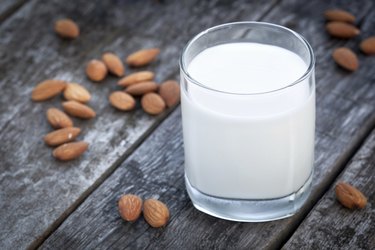
Calcium carbonate is a popular dietary supplement used to increase calcium levels. You might see it as a calcium supplement, as an ingredient in antacids, or as an additive in food.
Calcium Carbonate is approved for use in food with no limitations, according to the U.S. Food and Drug Administration. Calcium carbonate is a natural product, but doesn't naturally occur in foods; learn which foods have this ingredient added to boost their calcium content.
Video of the Day
Video of the Day
Tip
Calcium carbonate is used as a dietary supplement and food additive. Many calcium-fortified foods, including non-dairy “milks,” waffles and cereal bars contain the additive.
About Calcium Carbonate
Calcium carbonate is found throughout the world, as part of the earth's crust. You find it in chalk, limestone and marble — it's also present in the shells of shellfish, explains the Industrial Minerals Association of America. It's used to make building materials, paper, plastics, paints and chalkboard chalk.
Calcium carbonate is also a dietary supplement used to boost your dietary consumption of the mineral when your diet is calcium-deficient. You need calcium for healthy bones, a well-functioning nervous system, proper heart function and smooth moving muscles, explains Medline Plus.
Adults require 1,000 to 1,200 milligrams of calcium per day. Calcium carbonate supplements usually supply 500 to 600 milligrams per tablet, according to the Cleveland Clinic.
Calcium carbonate is sometimes used as an antacid, as it has a high alkalinity and can neutralize stomach acid. Chew the tablets thoroughly before swallowing, and never exceed the recommended dose.
If you take calcium carbonate as a dietary supplement, consume it with food or right after meals. The National Institutes of Health explains that it's best-absorbed in the presence of food.
When used as a food additive, calcium carbonate acts as an anti-caking agent, an added source of calcium and a white food color. It is also a nutrient for yeasts, an acid reducer and a firming agent, explains PubChem. Calcium carbonate can also stabilize and thicken some products, and be used to strengthen dough.
Calcium Carbonate in Food
Calcium carbonate is in baking powder, dry-mix dessert mixes, dough and wine. It's also used in animal feed. Huber Engineered Materials explains the multiple potential uses of calcium carbonate in food, which include:
- Breakfast cereal
- Nutritional bars
- Baked foods
- Fortified beverages
- Cookies and crackers
- Soups and sauces
Ultimately, to know if a product has calcium carbonate in it, you have to read the ingredient list. Not all calcium-fortified foods use calcium carbonate, either. For example, Tropicana fortified orange juice, contains tricalcium citrate as the calcium source. The company claims it offer superior absorbance when compared to calcium carbonate. Other calcium-fortifying ingredients include gluconate, lactate and phosphate. Calcium citrate malate is another form, and is found in several brands of juice.
Specific foods that do have calcium carbonate on the label include many types of Kellogg's Nutri-grain bars, Eggo waffles and Quaker breakfast cookies. Not all non-dairy "milks" contain calcium carbonate, but Silk brand products do — including Silk's almond milk, cashew milk and soy milk. Some commercial breads, including Wonder Bread, also contain calcium carbonate.
Whole Food Sources of Calcium
You don't have to rely on calcium carbonate in food or supplements to meet your body's daily calcium needs. In fact, supplemental calcium carbonate can cause gastrointestinal side effects such as bloating, constipation and gas.
Whole-food options for calcium are varied. Dairy products, such as cow's milk yogurt, cheese and milk, are all excellent calcium sources. One way to get all the calcium you need is to eat three cups of food from these sources. A 1.5-ounce serving of hard cheese (such as cheddar) counts as a cup.
You can also get calcium from foods such as kale and broccoli, as well as canned sardines or salmon with the bones intact. Spinach does contain a lot of calcium, but other compounds in the vegetable inhibit your body's ability to absorb it optimally.
Non-dairy milks and juices, tofu, cereals and grains aren't really good sources unless they are fortified. Foods fortified with calcium carbonate (or other forms of calcium) are still good sources of the mineral to include in your diet, especially if you don't eat a lot of dairy.
- Medline Plus: "Calcium Carbonate"
- FDA: "Calcium Carbonate"
- Office of Dietary Supplements: "Calcium"
- PubChem: "Calcium Carbonate"
- Huber Engineered Materials: "Food/Beverage Grade Calcium Carbonate"
- National Institutes of Health: "What are Good Sources of Calcium?"
- SmartLabel: "Kellogg's® Nutri-Grain® Soft Baked Breakfast Bars Raspberry"
- Smartlabel: "Kellogg's® Eggo® Buttermilk Waffles"
- Silk: "Unsweet Almond Milk"
- Quaker: "Quaker Breakfast Cookies"
- Industrial Mineral Associations of America: "What is Calcium Carbonate"
- Tropicana: "Orange Juice with Calcium & Vitamin D (No Pulp)"
- Cleveland Clinic: "Increasing Calcium in Your Diet"
- Walmart: "Wonder Bread"
- Medline Plus: Calcium in the Diet
- National Institutes of Health Office of Dietary Supplements: Calcium-Consumer